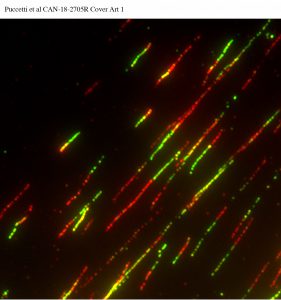From the Journals: Editors’ Picks
As a regular feature on this blog, we spotlight 10 “must read” articles selected by our editors from each journal issue published by the American Association for Cancer Research (AACR). For the past month, articles span from a preclinical study of a selective HER-2 inhibitor to a report on the prevalence of cancer risk factors and screening rates in the United States. As always, all articles summarized here are freely available for a limited time.
Journal: Cancer Immunology Research
CD96 Is an Immune Checkpoint That Regulates CD8+ T-cell Antitumor Function
One of the major approaches of cancer immunotherapy is inhibiting immunosuppressive pathways, such as CTLA-4 or the PD-1/PD-L1 axis. Because tumor cells can find ways to circumvent this strategy, the identification of additional immune checkpoints is an area of active investigation. In this study, the authors found that blocking CD96, a receptor that can mediate natural killer-cell effector function, inhibited tumor growth in several murine models of cancer in a CD8+ T cell-dependent fashion. Furthermore, the addition of anti-CD96 enhanced the antitumor efficacy of anti-PD-1, anti-PD-L1, anti-CTLA-4, and anti-TIGIT in murine models, and the triple inhibition of CD96, PD-1, and TIGIT provided superior responses compared to any dual inhibition combination. These results suggest that CD96 is an immune checkpoint expressed on CD8+ T cells that could be exploited to suppress tumor growth in multiple types of cancer.
Journal: Cancer Epidemiology, Biomarkers & Prevention
This article outlines the prevalence of modifiable cancer risk factors, screening utilization, and vaccination rates in the U.S. adult population. Using publicly available data from population-based surveys, the authors found disparities based on educational attainment and race/ethnicity. Smoking prevalence was six-fold higher in males without a high school education compared to females with a college degree. Excess body weight was observed in roughly 70 percent of whites, roughly 75 percent of blacks, and roughly 80 percent of Hispanics. Among women, roughly a third of those with a college education were obese, while almost half of women without a college degree were obese. Compared to college graduates, screening for breast, cervical, and colorectal cancer was 20-30 percent lower in those without a high school education; screening was lower among Hispanics, Asians, and American Indians/Alaska Natives compared to whites and blacks. The authors conclude that multilevel efforts are required to increase screening and vaccination rates and decrease the prevalence of modifiable risk factors in all populations, especially among racial/ethnic minorities and those with lower socioeconomic status.
Journal: Clinical Cancer Research (April 15 issue)
While many patients with HER2-positive breast cancer respond to trastuzumab, a subset of patients do not. In this study, the authors investigated the role of the oncogenic transcription factor WW-binding protein 2 (WBP2) in regulating the response to trastuzumab. Utilizing retrospective studies in HER2-positive breast cancer patients treated with trastuzumab-based neoadjuvant therapy, the researchers found that the combination of HER2 and nuclear WBP2 overexpression was associated with worse prognosis compared to the overexpression of either protein alone, and that higher expression of WBP2 is associated with a better pathological response. Additionally, the authors found that elevated WBP2 expression augmented trastuzumab treatment response in a variety of preclinical models, suggesting that WBP2 expression is a potential biomarker for response to trastuzumab treatment in patients with HER2-positive breast cancer.
Journal: Cancer Discovery
One method of tumor immune evasion is the downregulation of genes in the major histocompatibility complex (MHC), which present antigens to T cells and facilitates tumor-cell destruction. In this study, the authors utilized genomic, transcriptomic, and immunophenotypic analyses to determine the underlying mechanisms for MHC loss in 347 patients with diffuse large B-cell lymphoma (DLBCL). They found that mutations to the epigenetic regulator gene EZH2 were linked to the loss of MHC expression, and that treatment of EZH2-mutated DLBCL cell lines with EZH2 inhibitors could restore MHC expression. The authors conclude that these results could lead to new immunotherapy combinations that address both tumor and host immunity.
Journal: Cancer Research (April 1 issue)
Smarcal1 and Zranb3 Protect Replication Forks from Myc-induced DNA Replication Stress

This article was featured on the cover of this issue of Cancer Research. Using DNA fiber labeling, the authors captured DNA strands from the B cells of transgenic mice that are deficient in either the Smarcal1 or Zranb3 gene to identify terminated replication or stalled replication forks.
DNA replication stress, which can lead to stalled or collapsed replication forks, is a source of genomic instability that contributes to cancer; however, the specific proteins involved in the DNA replication stress response remain under study. Here, the authors interrogated how the related fork-remodeling proteins Smarcal1 and Zranb3 resolve replication stress in Myc-overexpressing primary cells and in transgenic mouse models. They found that these two proteins have essential and non-redundant biological functions in the DNA replication stress response, and that they contribute differently to Myc-induced lymphoma development, as haploinsufficiency of Smarcal1 or Zranb3 resulted in accelerated lymphomagenesis or inhibited lymphoma development, respectively. These results suggest that Smarcal1 and Zranb3 could be potential therapeutic targets for Myc-driven cancers.
Journal: Molecular Cancer Research
SPHK1 Is a Novel Target of Metformin in Ovarian Cancer
Sphingolipids, such as sphingosine, are important lipid-signaling molecules that are believed to regulate tumor progression. In this study, the authors found that hypoxia-inducible factors (HIFs) increased the expression of sphingosine kinase-1 (SPHK1), which regulates the phosphorylation of sphingosine-1 to sphingosine-1-phosphate (S1P), in ovarian cancer cells. The SPHK1-S1P axis was shown to drive the proliferation, migration, and invasion of ovarian cancer cells and promoted tumor growth in a xenograft model of ovarian cancer. The researchers also found that the antidiabetic drug metformin inhibited SPHK1 activity, and patients taking metformin had reduced S1P in serum. Finally, ovarian cancer cells with high SPHK1 expression were shown to be more sensitive to metformin-induced cytotoxicity. The authors conclude that ovarian tumors with high levels of S1P or SPHK1 may have increased sensitivity to metformin.
Journal: Cancer Research (April 15 issue)
Epithelial-mesenchymal transition (EMT) has been linked to cancer invasion and metastasis, and facilitating a stable mesenchymal state is a potential way to mitigate disease progression. In this study, the authors evaluated a reversible model of EMT in breast cancer cells, and found that the activity of spleen tyrosine kinase (SYK) was increased following EMT. Treatment of breast cancer cells with an SYK inhibitor stabilized the mesenchymal morphology, and systemic inhibition of SYK inhibited metastasis in a mouse model. The authors conclude that SYK activity could serve as a potential biomarker for advanced disease and that the inhibition of SYK may limit breast cancer metastasis.
Journal: Molecular Cancer Therapeutics
While several anti-HER2 therapeutics exist, many patients develop resistance to these treatments; HER2 inhibitors in development act as pan-ERBB tyrosine kinase inhibitors, which can result in off-target toxicity. In this study, the authors investigated the preclinical efficacy of the HER2-selective inhibitor TAS0728. Through a biochemical panel and cellular assays, the researchers found that TAS0728 was preferentially specific for HER2 compared to EGFR, and TAS0728 inhibited the phosphorylation of HER2, HER3, and downstream effectors in HER2-amplified breast cancer cells, resulting in apoptosis. Furthermore, treatment with TAS0728 facilitated tumor regression in mouse xenograft models. The authors note that a clinical trial evaluating TAS0728 in patients with solid tumors harboring HER2 or HER3 aberrations is ongoing.
Journal: Clinical Cancer Research (April 1 issue)
An active area of investigation is the identification of biomarkers to predict response to anti-PD-1 immunotherapy; this study evaluated the prognostic significance of Ki-67, a marker of proliferation, in T cells isolated from patients with thymic epithelial tumors (TET) and non-small cell lung cancer (NSCLC) treated with anti-PD-1 therapy. The researchers found that higher fold changes of Ki-67+ cells measured immediately before treatment (D0) and seven days following the first dose (D7) among PD-1+CD8+ T cells (referred to as Ki-67 D7/D0) could predict response to treatment. Specifically, a Ki-67 D7/D0 of 2.8 or greater was associated with durable clinical benefit, progression-free survival, and overall survival. Additionally, because nearly 90 percent of patients with a Ki-67 D7/D0 less than 2.8 experienced progression within six months, the authors posit that this biomarker could stratify patients based on response to anti-PD-1 therapy.
Journal: Cancer Prevention Research
Preparing foods with deep-fried oils, especially thermally abused frying oil (TAFO; oil that has been utilized repeatedly), can lead to the accumulation of lipid products, which raises nutrition-related health concerns. In this study, the authors analyzed metastatic tumor formation in murine models of late-stage breast cancer fed with either fresh soybean oil (SBO) or TAFO. Compared to mice that consumed SBO, mice that consumed TAFO had increased lung tumor metastases with increased levels of Ki-67 and increased liver to animal weight ratios, which showed altered expression of enzymes involved in lipid and xenobiotic metabolism pathways. The authors conclude that breast cancer metastasis was promoted by the consumption of TAFO in this model.



